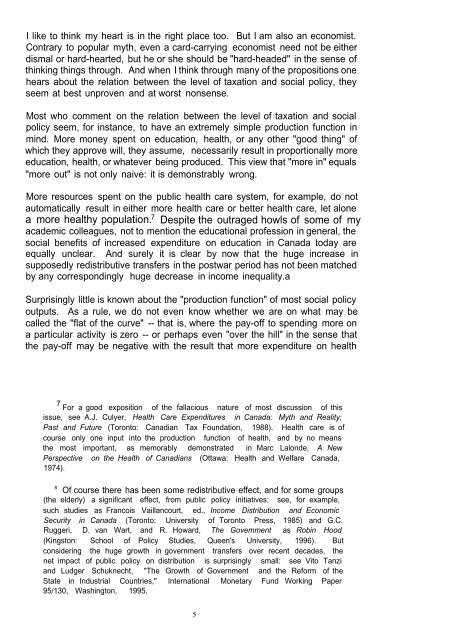Richard Bird - Institute for Public Economics - University of Alberta
Richard Bird - Institute for Public Economics - University of Alberta
Richard Bird - Institute for Public Economics - University of Alberta
Create successful ePaper yourself
Turn your PDF publications into a flip-book with our unique Google optimized e-Paper software.
I like to think my heart is in the right place too. But I am also an economist.Contrary to popular myth, even a card-carrying economist need not be eitherdismal or hard-hearted, but he or she should be "hard-headed" in the sense <strong>of</strong>thinking things through. And when I think through many <strong>of</strong> the propositions onehears about the relation between the level <strong>of</strong> taxation and social policy, theyseem at best unproven and at worst nonsense.Most who comment on the relation between the level <strong>of</strong> taxation and socialpolicy seem, <strong>for</strong> instance, to have an extremely simple production function inmind. More money spent on education, health, or any other "good thing" <strong>of</strong>which they approve will, they assume, necessarily result in proportionally moreeducation, health, or whatever being produced. This view that "more in" equals"more out" is not only naive: it is demonstrably wrong.More resources spent on the public health care system, <strong>for</strong> example, do notautomatically result in either more health care or better health care, let alonea more healthy population. 7 Despite the outraged howls <strong>of</strong> some <strong>of</strong> myacademic colleagues, not to mention the educational pr<strong>of</strong>ession in general, thesocial benefits <strong>of</strong> increased expenditure on education in Canada today areequally unclear. And surely it is clear by now that the huge increase insupposedly redistributive transfers in the postwar period has not been matchedby any correspondingly huge decrease in income inequality.aSurprisingly little is known about the "production function" <strong>of</strong> most social policyoutputs. As a rule, we do not even know whether we are on what may becalled the "flat <strong>of</strong> the curve" -- that is, where the pay-<strong>of</strong>f to spending more ona particular activity is zero -- or perhaps even "over the hill" in the sense thatthe pay-<strong>of</strong>f may be negative with the result that more expenditure on health7 For a good exposition <strong>of</strong> the fallacious nature <strong>of</strong> most discussion <strong>of</strong> thisissue, see A.J. Culyer, Health Care Expenditures in Canada: Myth and Reality;Past and Future (Toronto: Canadian Tax Foundation, 1988). Health care is <strong>of</strong>course only one input into the production function <strong>of</strong> health, and by no meansthe most important, as memorably demonstrated in Marc Lalonde, A NewPerspective on the Health <strong>of</strong> Canadians (Ottawa: Health and Welfare Canada,1974).8Of course there has been some redistributive effect, and <strong>for</strong> some groups(the elderly) a significant effect, from public policy initiatives: see, <strong>for</strong> example,such studies as Francois Vaillancourt, ed., Income Distribution and EconomicSecurity in Canada (Toronto: <strong>University</strong> <strong>of</strong> Toronto Press, 1985) and G.C.Ruggeri, D. van Wart, and R. Howard, The Govemment as Robin Hood(Kingston: School <strong>of</strong> Policy Studies, Queen's <strong>University</strong>, 1996). Butconsidering the huge growth in government transfers over recent decades, thenet impact <strong>of</strong> public policy on distribution is surprisingly small: see Vito Tanziand Ludger Schuknecht, "The Growth <strong>of</strong> Government and the Re<strong>for</strong>m <strong>of</strong> theState in Industrial Countries," International Monetary Fund Working Paper95/130, Washington, 1995.5



